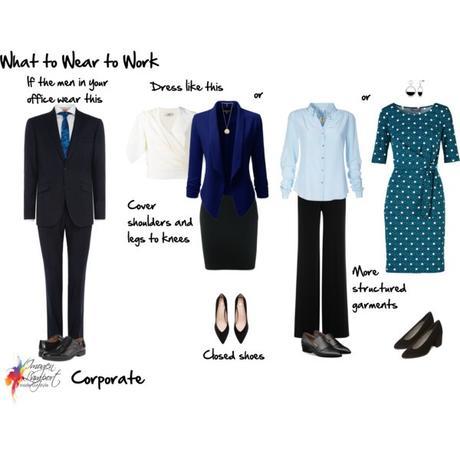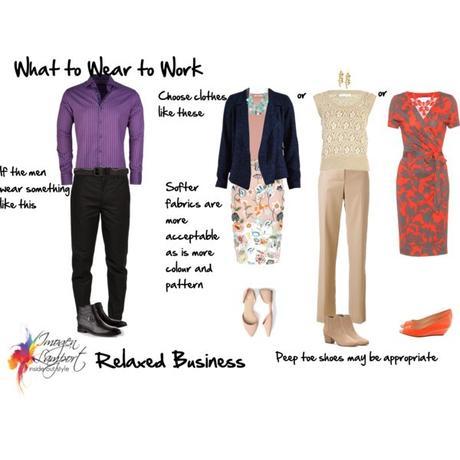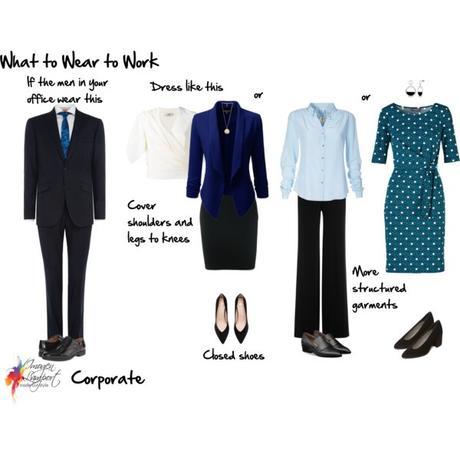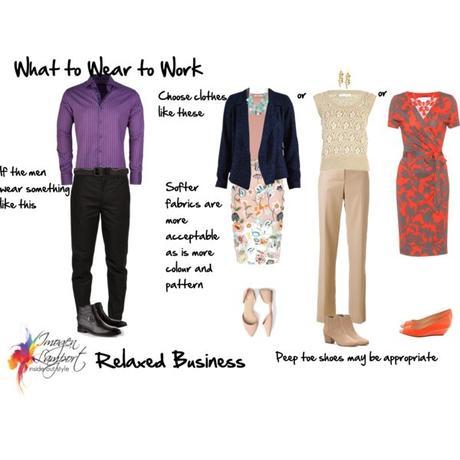Jill Chivers of Shop Your Wardrobe and I were asked to comment on the question of "how much skin is appropriate to show in the workplace". Now we are aware this can be quite a contentious as there will be some wildly differing views on this topic depending on your culture, your work environment, job, age and even religious or moral views.
Because the choice in women's clothing is much broader than for men (men's clothes are more limited, no dresses or skirts for example), means women often feel then that their choices for what to wear to work encompass that full range of options, rather than being more aware of the equality between what the men in their workplace may be required to wear and so what is that female equivalent?
Looking towards the upper management to see what the dress code is at that level will give you an idea of what is appropriate in your workplace.
Given that the human eye is attracted to skin, as skin is something we find exciting to look at (that's why strippers of both genders get undressed, slowly to extend that anticipation and excitement).
Showing a lot of skin can make those around uncomfortable, particularly when it's not in an environment (such as the beach) where you'd expect to see lots of skin, many people say they just don't know where to look (as they don't want to be inappropriate with their gaze).
Clothing in the workplace can work like armour. This is why Yang (or more authoritative clothing) design details and clothing is in the Classic clothing style (think suits and crisp buttoned-up shirts with collars), versus the more Yin (approachable) clothing styles and details (think relaxed knits and soft fabrics and unstructured styles) are not part of the formal businesswear dress code.
Think about how your clothing communicates (which we've talked about in other videos and Jill mentions this book The Language of Clothes), some clothes can be read as the equivalent of swearing. And so this is why these kinds of clothes are not appropriate at work.
Think about what am I signalling? What would I like to signal? Then use your knowledge of Yin and Yang and how clothes communicate to make your clothing choices, including how much skin you choose to show in your workplace.
Take Your Cue from The Men in Your Office
 The easiest way to take your cues on what is acceptable in your workplace is to look at what the men's dress code is.
The easiest way to take your cues on what is acceptable in your workplace is to look at what the men's dress code is.
If a man is wearing a suit, he's completely covered except for his face and hands. The female equivalent is dress pants or a skirt down to the knees, closed to shoe, and shoulders covered.
 If a man is wearing a polo shirt, then a sleeveless dress and an open sandal may be appropriate (OHS requirements withstanding).
If a man is wearing a polo shirt, then a sleeveless dress and an open sandal may be appropriate (OHS requirements withstanding).
 We are all reading clothes all the time (whether you realise you're doing it or not). This is why costume design is such an important part of any movie or tv show. And it's fascinating to read about just how much those clothes are altered to fit the actor ( makes you realise that alterations should be a part of every garment purchasing decision).
We are all reading clothes all the time (whether you realise you're doing it or not). This is why costume design is such an important part of any movie or tv show. And it's fascinating to read about just how much those clothes are altered to fit the actor ( makes you realise that alterations should be a part of every garment purchasing decision).
How to Express the Right Message Whilst Flattering Your Body Shape
Why Actors Wear Costumes
If You Were a Character in a Movie What Would You Wear?
How to Put Together a Corporate Wardrobe on a Budget
Understanding the Power of Colour in Your Wardrobe
How You Can Use Colours to Communicate For You

Jill Chivers of Shop Your Wardrobe and I were asked to comment on the question of "how much skin is appropriate to show in the workplace". Now we are aware this can be quite a contentious as there will be some wildly differing views on this topic depending on your culture, your work environment, job, age and even religious or moral views.
Because the choice in women's clothing is much broader than for men (men's clothes are more limited, no dresses or skirts for example), means women often feel then that their choices for what to wear to work encompass that full range of options, rather than being more aware of the equality between what the men in their workplace may be required to wear and so what is that female equivalent?
Looking towards the upper management to see what the dress code is at that level will give you an idea of what is appropriate in your workplace.
Given that the human eye is attracted to skin, as skin is something we find exciting to look at (that's why strippers of both genders get undressed, slowly to extend that anticipation and excitement).
Showing a lot of skin can make those around uncomfortable, particularly when it's not in an environment (such as the beach) where you'd expect to see lots of skin, many people say they just don't know where to look (as they don't want to be inappropriate with their gaze).
Clothing in the workplace can work like armour. This is why Yang (or more authoritative clothing) design details and clothing is in the Classic clothing style (think suits and crisp buttoned-up shirts with collars), versus the more Yin (approachable) clothing styles and details (think relaxed knits and soft fabrics and unstructured styles) are not part of the formal businesswear dress code.
Think about how your clothing communicates (which we've talked about in other videos and Jill mentions this book The Language of Clothes), some clothes can be read as the equivalent of swearing. And so this is why these kinds of clothes are not appropriate at work.
Think about what am I signalling? What would I like to signal? Then use your knowledge of Yin and Yang and how clothes communicate to make your clothing choices, including how much skin you choose to show in your workplace.
Take Your Cue from The Men in Your Office
 The easiest way to take your cues on what is acceptable in your workplace is to look at what the men's dress code is.
The easiest way to take your cues on what is acceptable in your workplace is to look at what the men's dress code is.
If a man is wearing a suit, he's completely covered except for his face and hands. The female equivalent is dress pants or a skirt down to the knees, closed to shoe, and shoulders covered.
 If a man is wearing a polo shirt, then a sleeveless dress and an open sandal may be appropriate (OHS requirements withstanding).
If a man is wearing a polo shirt, then a sleeveless dress and an open sandal may be appropriate (OHS requirements withstanding).
 We are all reading clothes all the time (whether you realise you're doing it or not). This is why costume design is such an important part of any movie or tv show. And it's fascinating to read about just how much those clothes are altered to fit the actor ( makes you realise that alterations should be a part of every garment purchasing decision).
We are all reading clothes all the time (whether you realise you're doing it or not). This is why costume design is such an important part of any movie or tv show. And it's fascinating to read about just how much those clothes are altered to fit the actor ( makes you realise that alterations should be a part of every garment purchasing decision).
How to Express the Right Message Whilst Flattering Your Body Shape
Why Actors Wear Costumes
If You Were a Character in a Movie What Would You Wear?
How to Put Together a Corporate Wardrobe on a Budget
Understanding the Power of Colour in Your Wardrobe
How You Can Use Colours to Communicate For You


